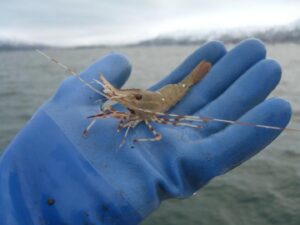
Shrimp — Kumitgarpak
Kumitgarpat piturnirtaartut. – Shrimp are tasty.
There are five species of shrimp in Gulf of Alaska waters—including coonstripe, sidestripe, humpy, northern, and spot varieties. The Alaska spot prawn (Pandalus platyceros) is the largest and a popular addition to dinner tables. These tasty invertebrates are found from northern British Columbia to the eastern Aleutian Island. They can grow up to 23 cm long and have a brown or tan carapace with distinctive white spots on the abdomen.
The Alutiiq word for shrimp, kumitgarpak, translates as big beach flea! This name reflects the physical resemblance between ocean-dwelling shrimp and the tiny, annoying crustacea found widely on Kodiak beaches. It also suggests that shrimp were not a traditional subsistence food, as they are named after a pest. Shrimp are a deep-sea resource, and although likely abundant and known to the Alutiiq for millennia, they were not commonly harvested food until the twentieth century. This may be because shrimp are scavengers. They feed off organic matter that sinks to the ocean floor. Like crabs, which were traditionally avoided by the Alutiiq, they eat the dead.
On Kodiak and the coast of the Alaska Peninsula, shrimp became an important commercial seafood resource in the mid-twentieth century. They were typically taken with trawl gear and to a lesser degree with pots. The fishery began in ca. 1958 and continued into the mid-1980s when the population plummeted due to warming waters and increased predation. Today, recreational and subsistence fishermen take them with pots. In Kenai Peninsula, Alutiiq communities shrimp are particularly popular and make up about a quarter of all the invertebrates people harvest.
